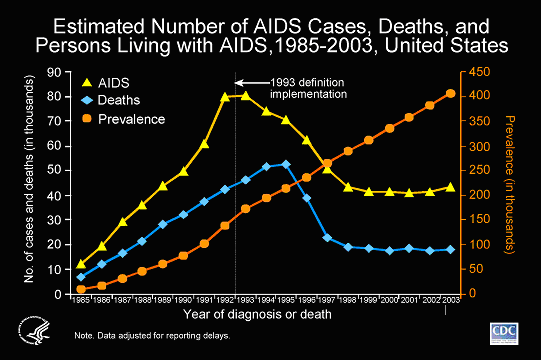Lesson 3
Essential Questions
- To what extent can a pandemic disease affect a society?
- To what extent are pandemics inevitable?
Background
Nearly three decades ago, the HIV virus that causes AIDS was first identified. Awareness of AIDS and its economic impact upon human society has increased with its spread. First seen as a disease exclusive to homosexuals and drug users, it has become a global health epidemic and a threat to development in Third World countries.

Globally, the disease has spread shockingly fast. The 2005 United Nations report on AIDS estimates that 40.3 million people are infected with HIV. At least 4.3 million people alone became infected in 2005. Ninety percent of new infections are in developing countries, where life expectancy has decreased by up to 20 years. AIDS has killed more than 20 million people in 25 years.
Africa alone accounts for 67% of the total number of infected persons worldwide, though the beleaguered continent accounts for only 11% of total world population. One in 12 African adults is infected. Sub-Saharan Africa has just over 10% of the world’s population, but is home to more than 60% of all people living with HIV—25.8 million. In 2005, an estimated 3.2 million people in sub-Saharan Africa became newly infected, while 2.4 million adults and children died of AIDS.
When backed by political commitment, treatment programs and behavior modification programs are successful in slowing the rate of spread of HIV. Nevertheless, the failure of African and world leaders to recognize the gravity of the pandemic and the failure of governments from developed nations to respond effectively to the crisis leaves the future of Africa in doubt.
Instructional Strategies
 |
Strategy 1 |
Gathering Information: Accessing Prior Knowledge
Ask students What do you think about when someone mentions the continent of Africa? Conduct a Think/Pair/Share activity in which students brainstorm possible responses individually, then in pairs, and then share ideas with the class.
New information is best learned by relating it to prior knowledge. Explain to students that a "Taking-Stock Table" is a strategy for linking new information to prior knowledge.
Have students complete the Taking-Stock table and fill in Columns 1 and 2 first independently and later as a class. Ideas can be written on the chalkboard or on a transparency. Corrections to student misunderstandings found in Column 1 can be made later in the module (see Strategy 6) as a check for understanding. Inform students that they will fill out the third column later in the unit.
Have students read The Shape of Africa by Jared Diamond. As in Activity 2, Strategy 3 of this module, students should use a more complex source of information by following these steps:
- Relate it to prior knowledge – review what students already know about Africa.
- Help students break the reading into parts.
- Add relevant vocabulary to the Word Wall (e.g. disease burden).
- Why does Africa continue to be shaped by its history and geography?
Check for Understanding = Formative Assessment
- Have students use Diamond’s article to add to column 3 of the Taking-Stock table.
- How did the additions to column 3 after reading the article by Jared Diamond change the information in columns 1 and 2?
 |
Strategy 2 |
Extending and Refining: Inquiry Chart
Have students complete an Inquiry Chart to answer this question:What is the best way to organize a global response to the AIDS pandemic?
Post several questions for students to explore. These are found at the top of each individual column. The rows are for recording, in summary form, the information you think you already know and the key ideas pulled from several different sources of information. The final row gives you a chance to pull together the ideas into a general summary or write new questions to which you still need answers. It's at this time you'll also try to resolve competing ideas found in the separate sources or, even better, develop new questions to explore based on any conflicting or incomplete information.
As students begin their study of the AIDS pandemic in Africa, these powerpoint slides from the World Health Organization and United Nations should be used to identify the extent of the problem. Have students examine the World Population of AIDS geo-graphic representation. It shows how nations and continents would look if their size were determined by the prevalence of HIV/AIDS.
These websites and others with similar information may be given to students to use for their focused research:
http://news.bbc.co.uk/2/hi/in_depth/africa/2005/africa/default.stm
http://news.bbc.co.uk/2/shared/spl/hi/africa/03/biology_of_aids/html/default.stm
http://www.unicef.org/aids/index.php
http://www.unicef.org/infobycountry/index.html
http://allafrica.com/
http://www.cdcnpin.org/scripts/hiv/index.asp
http://www.cdc.gov/hiv/dhap.htm
http://www.theglobalfund.org/en/
http://www.usaid.gov/our_work/global_health/aids/pepfarfact.html
http://www.avert.org/aidsdrugs.htm
Students and teachers may wish to modify the I-Chart, such as including a bottom row to list new questions. For example, a row in the I-chart has been set aside for teachers that might wish to have students practice the skill of creating an annotated bibliography using the websites above.
The AIDS Pandemic in Africa |
How does HIV/AIDS cause disease? | What is the extent of the economic and social impact of the AIDS pandemic in Africa? | How are non-governmental organizations and world governments cooperating to fight AIDS? |
What do I already know? |
|||
What did I learn from researching? |
|||
What questions do I have? |
|||
Annotated Bibliographic Entries How did I use the website provided?
|
Check for Understanding = Formative Assessment
- Should the governments of developed nations spend whatever is necessary to create a vaccine for AIDS?
- What impact would that have on the economies of developed nations?

http://www.cdc.gov/hiv/graphics/images/L207/l207-1.ppt
- What conclusions about the effectiveness of AIDS treatment programs can be drawn from this graph?
- How might the evidence in this graph support changes to the U.S. government AIDS treatment and prevention policy?
 |
Strategy 3 |
Extending and Refining: Reading for Information & Jigsaw
Remind students that information-gathering through reading and analysis of images is a purposeful activity that requires specific strategies and skills, as indicated in the chart below.
| Purpose: Why read for information? |
Strategies and Skills to guide Reading for Information |
| Develop global understanding |
|
| Develop interpretation |
|
| Form a personal response |
|
| Critically respond |
|
Have students read one of the following folders containing articles and images.
Folder #1: How does the HIV/AIDS pandemic impact Africa?Students should work cooperatively in groups of four to answer the question related to each folder. Within each group, have one student complete the Strategies and Skills for each of the rows in the chart above. For example, one student working on developing a global understanding will be assigned the task of summarizing the text looking for the main ideas, significant details, and underlying meaning for the group.Folder #2: What is the global response to the HIV/AIDS pandemic in Africa?
- Africa Starts to Care for AIDS Children.doc
- Africa's Homeless Widows.doc
- Farms disappearing in AIDS-ravaged Africa.doc
- In South Africa, Stigma Maginifies Pain of AIDS.doc
- shortage of health care workers map.pdf
- World population of AIDS geographic.pdf
- A World Without AIDS.doc
- Accountability theme of World AIDS Day.doc
- AIDS Plan Would Cut Drug Costs For Poor.doc
- AIDS study - therapies do help the poor.doc
- AIDS, TB Fund reports shortfall in donations.doc
- ARV therapy distribution.bmp
- Fact Sheet PEPFAR.doc
- Foreign Drugs Approved For Anti-AIDS program.doc
- Tanzania gets high-tech HIV treatment center.doc
Check for Understanding = Formative Assessment
- Once students are completed with their task, use a Jigsaw strategy in which all students working on developing a global understanding share their summaries, all students developing interpretation might compare their predictions or arrangement of events in chronological order, all students forming a personal response might distinguish between relevant and irrelevant information, and all students critically responding share their analysis and evaluation of the language used to persuade.
 |
Strategy 4 |
Application: Making Predictions
Students should choose one sub-Saharan African nation to research its history of HIV/AIDS, the impact of AIDS on the nation, and the effectiveness of strategies used to combat the spread of HIV/AIDS.
http://www.unicef.org/infobycountry/index.html
http://www.unaids.org/en/default.asp
http://www.avert.org/pepfar.htm
http://www.theglobalfund.org/en/
http://www.usaid.gov/our_work/global_health/aids/pepfarfact.html
http://www.avert.org/aidsdrugs.htm
http://devdata.worldbank.org/edstats/
http://www4.worldbank.org/afr/stats/default.cfm
http://www.cia.gov/cia/publications/factbook/
Check for Understanding = Formative Assessment
- Give a news report from the sub-Saharan African nation you selected on the AIDS pandemic in the year 2056: What happened to Africa and in the nation you selected?

 Module Menu
Module Menu Printable View
Printable View
